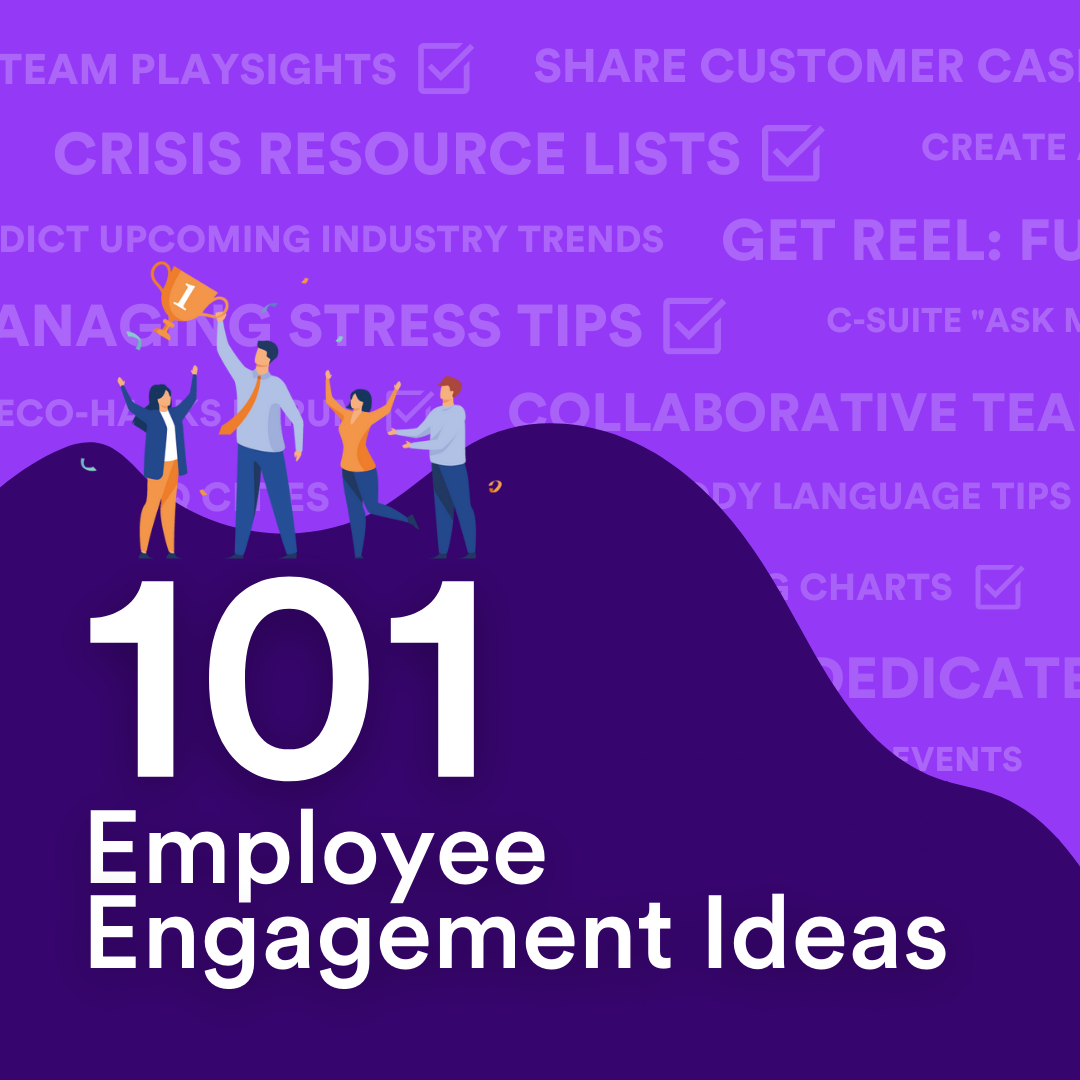Whether you’re an internal communicator, intranet manager, or HR, you may know the singular pain when your latest internal message or initiative gets little to no engagement. You spend time thinking up, creating, scheduling, and posting your exciting ideas only for…nothing. Crickets. Tumbleweeds.
We know that boosting employee interaction with company communications and content areas can help them to stay informed and feel connected, but it’s also a challenge. Employees have priorities aside from reading through the CEO’s recent blogs after all. In big organizations especially, people may be reluctant to interact with individuals and teams they don’t know.
Then there’s also what psychologists call the bystander effect. Counterintuitively, when lots of people are present in a crisis it becomes less likely that a single individual will act. Everyone assumes someone else will do something, so everyone does nothing. Comms can be a little like that too.
“Everyone else in the company has already liked or shared this, so I don’t need to.”
The question is, how can you counteract that feeling and encourage people to act in a way that increases intranet engagement? One possible way is by using insights from employee advocacy programs.
This article explores what employee advocacy is and suggests how you can turn employee advocacy tactics into better intranet engagement too.
- What is employee advocacy?
- How is employee advocacy different from employee engagement?
- What are the benefits of employee advocacy?
- How to build an employee advocacy program and improve intranet engagement
- Apply employee advocacy to your intranet engagement
What is employee advocacy?
Outside of its programmatic meaning, employee advocacy simply means having workers who are so engaged with an organization that they represent it positively and voluntarily within their own networks.
They post about it on social media, actively engage with its media content (blogs, social posts, reports, etc.), recommend people they know to work there, and wear its swag when they’re out and about.
Keep internal comms fresh with 101 Employee Engagement Ideas
In the context of employee advocacy as an intentional act though (what you might call Employee Advocacy), EA is a set of strategic and tactical actions that give employees everything they need to advocate for your company. This may include setting them up as ambassadors, incentivizing them, giving them a timeline of appropriate content, and offering social media training on how they can use it in an authentic way. EA means treating this kind of earned media mention as a serious marketing avenue. And lots of companies now do it.
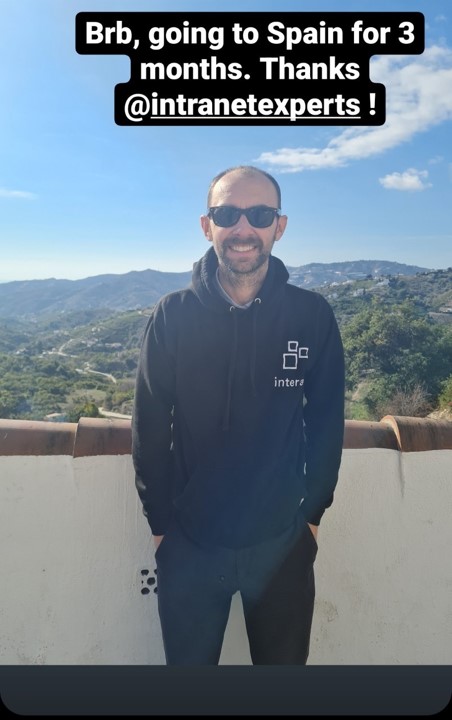
How is employee advocacy different from employee engagement?
In many cases, this comes down to who owns the process and where it takes place.
Employee engagement and experience are usually the responsibility of HR and comms professionals. They are tasked with creating intranet content ideas and internal communications that engage and connect their people internally.
Using multichannel communication tools such as intranet software, the end goal is to create better informed and happier workplaces.
As social media has grown, however, employee engagement has also taken on an external element. Shrewd marketers understand that brand authenticity depends on people who intimately know the product and the company (and who better than its employees?) making public recommendations for it. With this in mind, employee advocacy programs seek to find, equip, and reward those employees who are most likely to publicly celebrate being part of the enterprise.
So, while employee engagement (through intranet engagement as a single metric) remains an internal drive, boosting employee advocacy through organized programs is often co-owned between marketing and other people-focused teams in a business.
Crucially, employee advocacy programs now act for marketing teams as another pillar of social media and marketing strategies. The conventional wisdom is that if employees voluntarily broadcast to their networks via social media and other channels, you’re more likely to build a positive brand presence, attract new hires, and gain sales opportunities. Employee advocacy in this sense is another form of marketing.
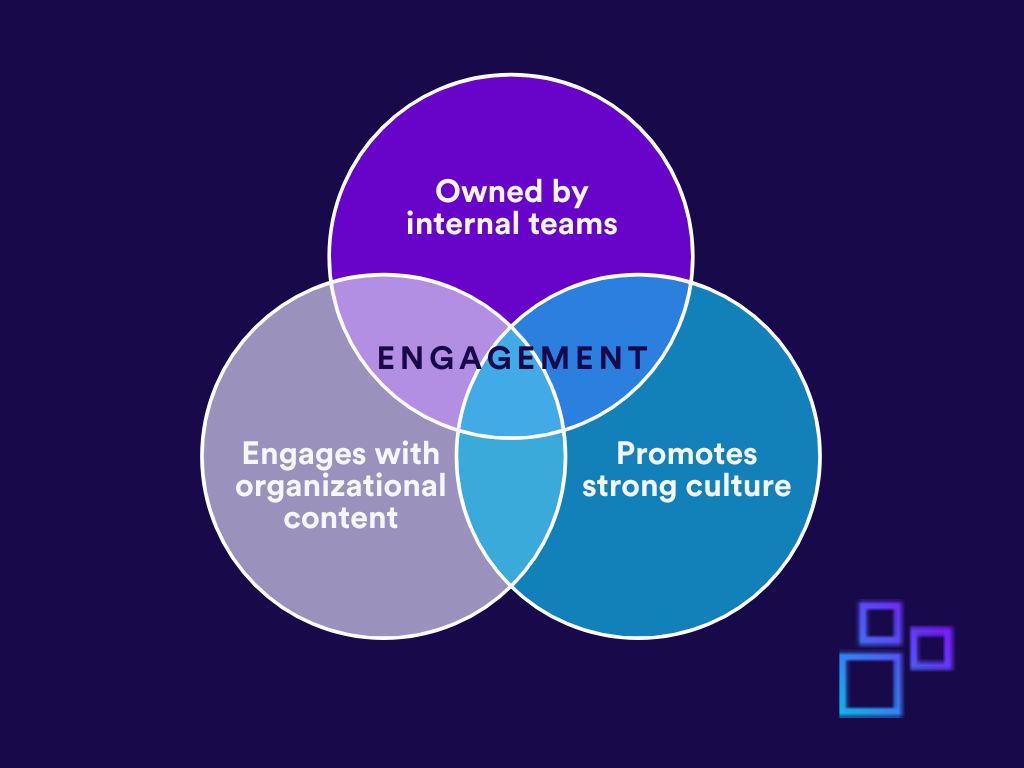
Some of the obvious differences between employee engagement and employee advocacy are summarized in these diagrams.
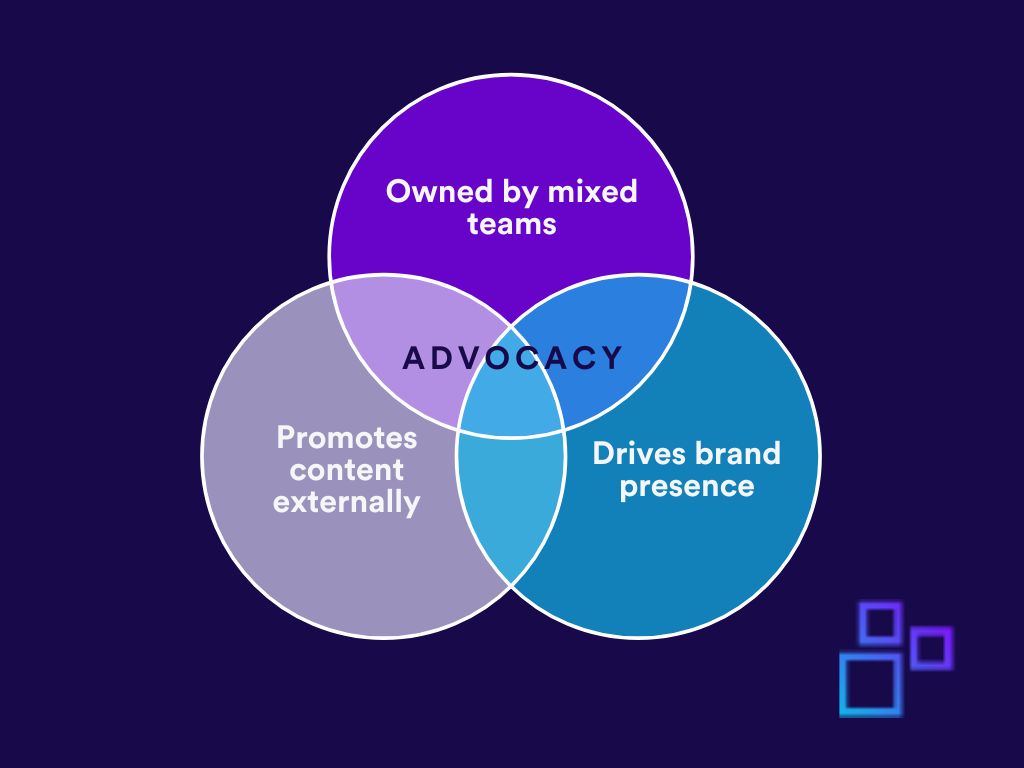
What are the benefits of employee advocacy?
If it’s done right, a good employee advocacy program should have positive benefits for both the company and the individuals promoting it.
By providing employees with the resources and tools to create interesting external content for their own audiences, everyone wins.
Some of the combined benefits include:
- Building a shared sense of purpose internally and externally
- Promoting a company as an employer and business partner
- Improving customer perception
- Driving employee creativity and connection
- Establishing the employee as a thought leader and the brand as a destination employer
These points are good in theory, but does the evidence support them? Research suggests it does.
One study of North American executives found that “On average, employees have 10 times more contacts than the official branded channels. Company branded messages reach 561% further when shared by employees versus branded channels.”
Given the way that social media platform algorithms often seem to limit the visibility of unpaid corporate posts (why would they give them away free when they can charge to advertise?), encouraging employees to share company content is an effective way to engage a wider network.
Keep internal comms fresh with 101 Employee Engagement Ideas
The real benefit though comes from the trust that these advocates build. Research from Nielsen suggests that when it comes to getting information on brands and services, a staggering 88% of people trust earned media – including recommendations from family and friends – over any other source.
As the digital landscape has grown more crowded and complex, personal networks have become more important, with personal trust growing to fill the gap.
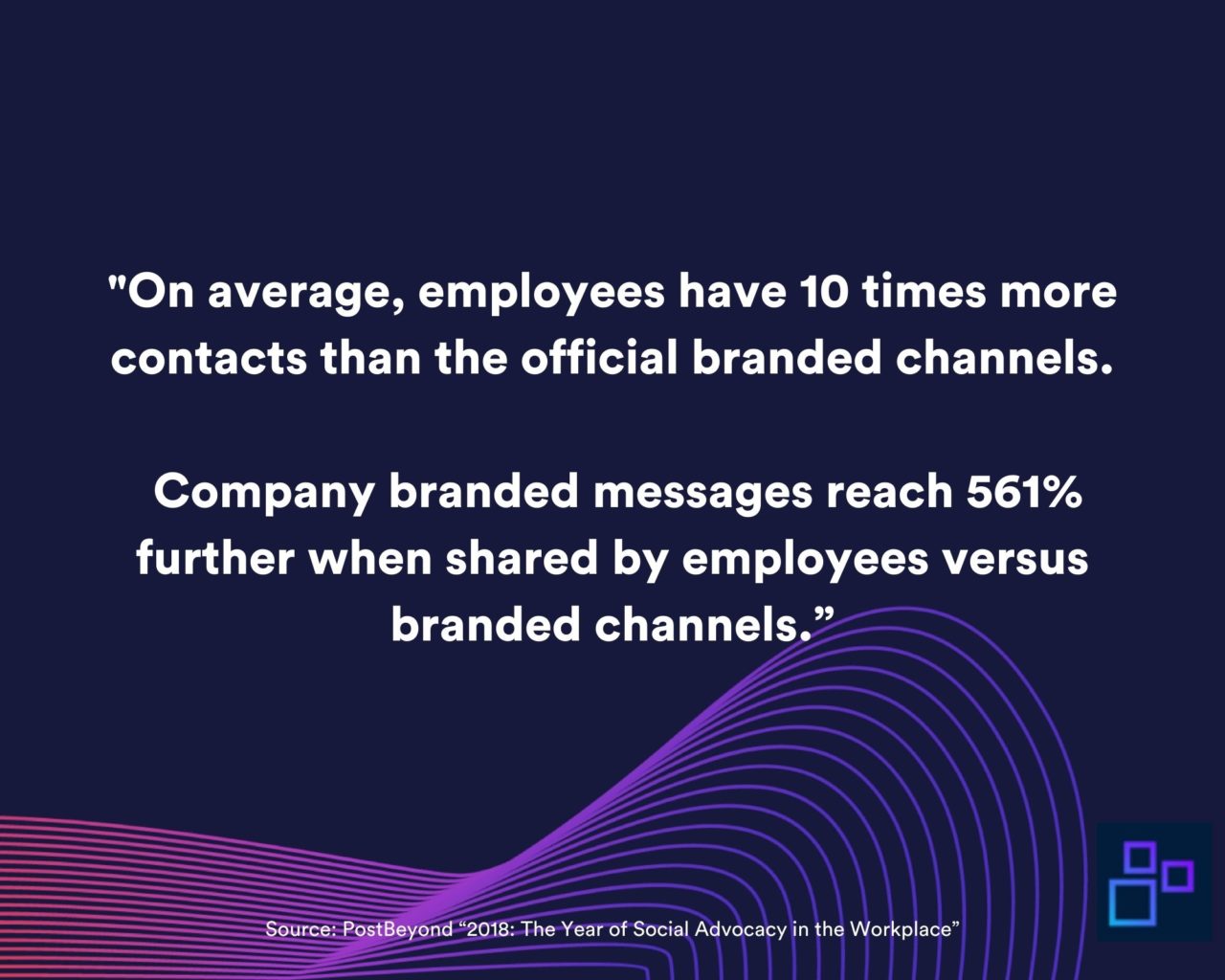
How to build an employee advocacy program and improve intranet engagement
Employee advocacy programs are designed to give individuals the tools and incentives to voluntarily engage with organizational content and communications. To work properly they must create a community of people within a business who are willing to advocate, and then give them ways to engage via social media on a regular basis.
If enterprises can do this for external interaction, we should be able to transfer the same principles to intranet engagement.
So, how do enterprises drive greater employee advocacy? The following points show how EA programs are created and how you can adapt them for better employee engagement.
#1 Begin with a POC
You may want to leap straight into providing thousands of employees with content and swag they can boast about, but it’s advisable to start small and ensure you can scale.
Creating a proof of concept (POC) is essential for bigger organizations especially because it allows them to test and learn with a cohort of employees before it gets rolled out further.
Some tips for designing an employee advocacy POC include:
- Identify and select a proportion of employees (2-5% may be a good start) you wish to include. Inevitably, not all employees will join the EA program, so the POC is about working with a smaller group of the group who will eventually participate. If your future plan is to have 100 employee advocates out of 1,000 total workers, start your POC group with between 20 and 50. Identifying these people will depend on your workplace, but the key thing is to ensure diversity. To avoid creating a bubble effect, seek out voices from right across the organization, in every team. Don’t forget to include those who don’t typically post or advocate. The goal of the POC is to see whether the program will succeed when people have the right tools and incentives, so there is no point in only utilizing those people who are already active.
- Define your goals. The POC gives you a chance to look at a small group of people and decide what success looks like and how achievable it is. If you provide 20 people with social media training and three months’ worth of content, how many times will they advocate during that time? Knowing what success is in a small group means you can scale upwards and create an adoption and communication plan.
- Provide training and guidelines. Having a small group of participants should make it easy to offer training and guidance on how you’d like marketing and advocacy to work together.
- Plan to scale your efforts. EA requires a continual effort because you need to provide fresh content, stimulate a community of advocates, offer new training, and keep people engaged. As your program grows from 20 to 100 or more, who will do what as it grows? How and when will you roll out the plan to more people? Will the marketing department provide everything or will a point of contact in each team provide more specific material that’s relevant for their people? It’s important to plan the structure of your EA community in advance.
Intranet engagement pro tip:
Designing a scalable intranet engagement plan works along the same lines as a POC. It’s likely that you will have certain teams, locations, or even countries where your internal communications just don’t seem to stimulate any engagement.
Rather than tackling everything in one go why not start small in these areas and try to isolate those individuals who may be important internal influencers. Once you have a list of possible people, work with them to develop content and processes that suit what they find engaging. It may be that your company’s global content is just not interesting for them but by starting at a local level you can grow engagement from grassroots.
In time, you’ll be able to see if those people can keep up the momentum of making regular interactions with you, hopefully building to even more from their colleagues.
#2 Create a community
With your POC behind you, it’s time to identify and build an even bigger group of brand ambassadors. There are many potential strands here, but one crucial one is whether you choose to create an internal sub-brand that marks these ambassadors out as special.
Having a designated group with its own name and branding (which can then live on a Slack or Teams channel and on your intranet) can create a sense of solidarity. It can also be a place where everyone can connect, suggest ideas for posts, and communicate about how they are networking. Having everyone together in one place is also ideal for internal communicators and marketers as they can update the entire group without having to use multiple avenues of communication.
Keep internal comms fresh with 101 Employee Engagement Ideas
Intranet engagement pro tip:
Your intranet is the perfect platform for building solid communities. Customize the branding of a page, give it a name, and send your members unique comms along the channels they are responsive to. By having a smaller group you’ll be better able to see who responds to what (mobile, employee email newsletter templates, app, etc) and which just don’t work.
Creating a team of influencers may help to build a better culture of communication throughout the organization.
#3 Reward and recognize
Employee advocacy should be a two-way street, with employers benefiting from publicity and employees being recognized for going the extra mile. Being seen as a thought leader and a positive force within their own network may be one externally motivating factor, but companies can also provide internal benefits such as employee recognition points (at Interact we give each other digital ‘donuts’) and company-wide acknowledgment.
Highlighting the efforts of your advocates during your all-hands meetings can help to foster recognition and increased buy-in too.
Many companies also now have employee referral bonuses for those who recommend successful new hires. Although this monetary compensation is not necessary for all advocacy tactics, it can support the company to recruit from a pool of trusted contacts.
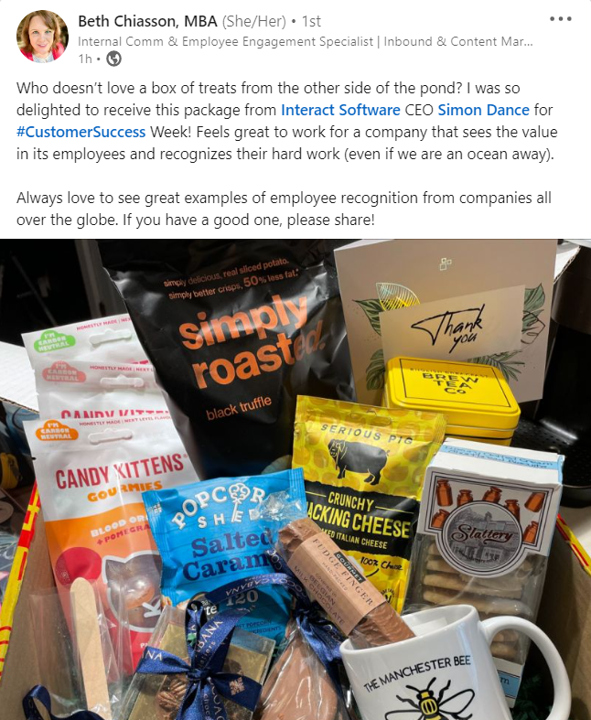
Intranet engagement pro tip:
Good feelings are viral, and it doesn’t take much to make people feel so good that they want to share that. It doesn’t have to be a gift box (like lucky Beth above), it can be a mention on your company’s intranet feed or a celebration on your social media feed. If people are going the extra mile for you internally then show you care and encourage senior leaders to make their mark on that too.
#4 Training and guidelines can make a difference
Having diverse voices advocating for you is important. It will also mean that you have some ambassadors who are less social-media savvy than their colleagues. To ensure that everyone can participate in an authentic way, most employee advocacy programs include elements of social media training and help participants connect with company guidelines.
Whether you choose to conduct this training in-house or via an external partner, there are several key things to remember.
- There are lots of platforms and you want employees to use those most aligned with their interests. If they don’t use LinkedIn then only giving them training and content for that channel will be largely pointless. Meet them where they live and provide actionable tips on how to create good company-referencing content. How would you like them to use company hashtags or logos? Is there a specific URL they need to use if they’re sharing blogs or guides? Treating EA as an extension of marketing strategy means that you want their actions to be trackable in the same way as conventional marketing.
- Platforms change and develop, which means training needs to change too. Assuming that you can write your training guide and rely on it indefinitely is a sure-fire way to create content that looks out-of-date or inauthentic when the platform changes.
- Social media guidelines should be just that, not hard and fast rules. Employee advocacy is about empowering people to be creative and to interpret some of the company content you provide. It can be good to suggest that you like to use a certain tone or specific words, but limiting people to ultra-specific rules will mean they never voluntarily get involved.
- The time your co-workers spend learning and then communicating on behalf of the company is still a form of work and should be understood as such. To guarantee full engagement you may need to liaise with managers and work out how much time EA activities will take. Your ambassadors can then be supported to post creatively in a way that benefits everyone. If EA posts are seen as an add-on that people should perform in their own time then this may alienate people and make them reluctant to act.
Intranet engagement pro tip:
Intranet content creation has become simpler with the advent of more advanced CMS intranet features. If you haven’t heard about Interact’s new content editor (which allows everyone to make awesome intranet pages!) then please take a look at this short video.
With a drag and drop page editor, it’s possible to give non-technical authors the power to make interesting pages that will cement their internal influencer status.
#5 Provide relevant, shareable content
Perhaps the most important part of an effective EA program (and an intranet engagement push) is the creation of a steady stream of engaging content.
If you can provide blogs, guides, images, and videos that all reflect people’s interests, they will be more inclined to share them with their networks.
Keep internal comms fresh with 101 Employee Engagement Ideas
Some considerations for good content scheduling:
- As with other marketing content, you need a timeline. Combine your editorial and social media calendars with an internal communications calendar to ensure that you are creating integrated content that reflects the business as a whole. If you are already producing external communications around Pride Month, for example, then it’s important to let your employee ambassadors know that in advance and to give them ideas and resources to create their own social posts too.
- Discover what your people are most interested in. Pulse surveys can be a quick way to ask about topics people like or dislike, and your intranet communities (or Slack/Teams channels) can be an ideal discussion forum. Use forms to gauge the popularity of certain topics and then work to provide greater resources around them. Experience suggests that people are interested in other people. Consider communicating well on internal promotions, community action, recent hires, product launches that relied on teamwork, get-togethers and socials, team events, DE&I, or other topics that connect people with your organization’s purpose.
- Global content is interesting but local content is even better. What’s going on in individual offices and at different locations? Tap into the knowledge of your dispersed teams and ensure that everyone is represented. If your local admin contacts can add some color to your global content plans then you should be equipped to provide more highly targeted communication.
- Give people lots of choices and cater to all platforms. Not everyone is interested in making high-level business commentary on company strategy, so having a wider variety of material can serve more people. Infographics, images of colleagues, and logo-stamped videos can all be highly interesting and highly shareable for people across your organization. If they can use these elements to create new social posts then even better.
An EA tool such as Sprout Social shows how some companies choose to create a topic timeline that employee advocates can use to keep in touch with what’s coming up. Having greater awareness means being able to pick and choose what they want to share.
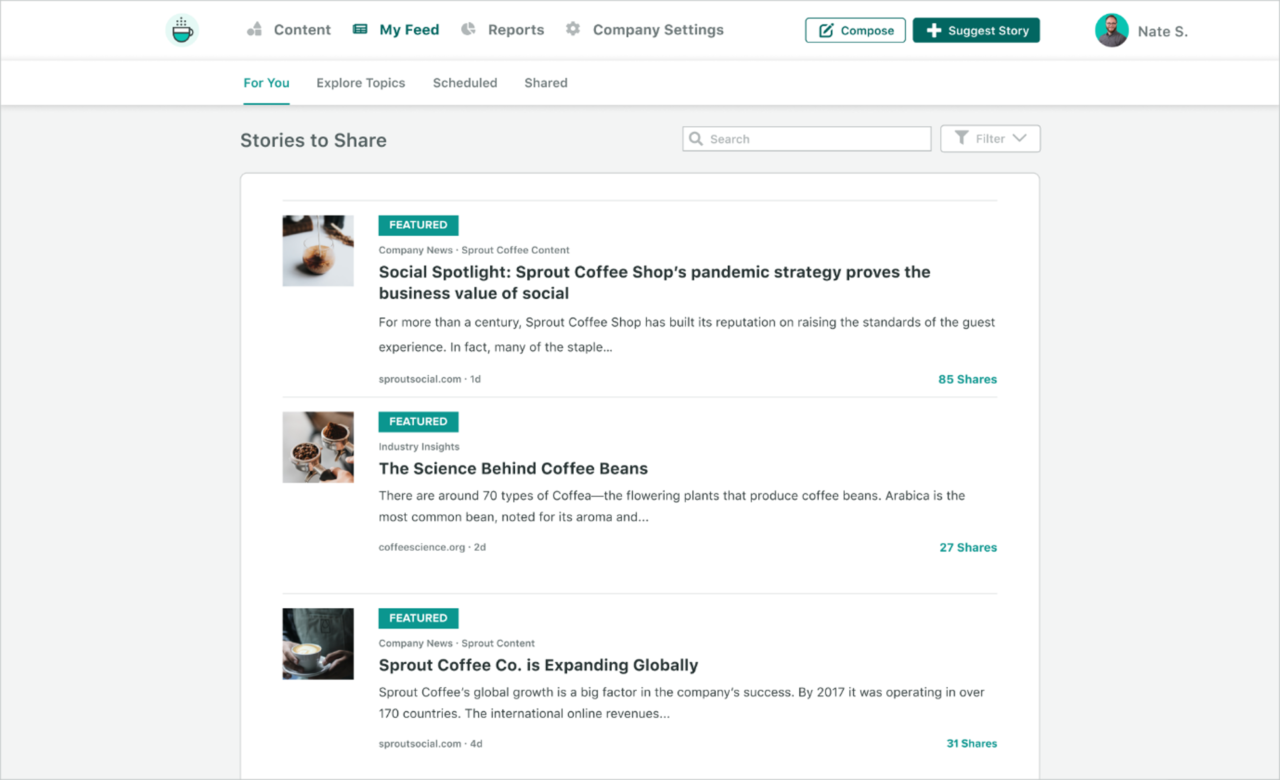
Intranet engagement pro tip:
Much like marketers, organized internal comms pros have their own calendars and timelines. You may be sharing employee stories during Pride or highlighting your latest interns, all balanced against what different stakeholders in the business want and need. By making time to share a version of your timeline with your ambassadors (and to give them some possible ways to interact with everything based on their locations and networks) you may be able to push that content further and generate a good feeling right across your workforce.
Apply employee advocacy to your intranet engagement
Employee advocacy on social media (and beyond) is so powerful that an entire industry of software tools and consultants has sprung up to support companies get more of it.
Ultimately, the goal of all these people is to give employees the tools and time they need to engage with company content and communications externally. If you consider that a modern intranet is also now used as an enterprise social network (with many of the same features and practices) then it’s not hard to cross apply some of these tactics to encourage intranet engagement internally.
As has been outlined above, if you start small but plan to scale big, you can create a group of intranet activists who can drive even greater engagement with your intranet. Offer them:
- Relevant, authentic content
- Social media guidelines and training
- Time and recognition
- Connection with the business
- A chance to use their voices
You just might see the engagement you hope for.
